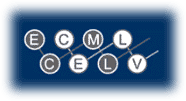
The Common European Framework Levels
and Profile Deutsch
- An Application at the Goethe Institut Bucharest -
Monica Aldea
![]()
The Goethe Institut in Bucharest has used Profile deutsch, and the Common European Scale of Reference to create greater transparency on learning objectives with its students. Here is a case study of how this was achieved.
A Case Study
The application workshop - held in Bucharest, March 2002, chaired by Dr.
Christiane Krämer-Hus-Hus, including among the participants the representatives
of all the German Cultural Centres in Romania - included the following
steps:
- assigning CEF levels and global competence descriptions to the courses held at the Goethe-Institut Inter Nationes in Bucharest
- a differentiation of the levels A1, A2 and B1 according to course planning: A1.0, A1.1, A1.2... and the corresponding description of the general and detailed competences
- a compilation of the course description for publicity purposes
- a description of the levels in point of 'can-do' statements as a quality language service
- the general and specific description of the 'can-do' statement of the respective courses
- an invitation to evaluate and (re)consider the teaching activities in order to achieve communicative language competences
- some hints about working out the means and media needed
Course levels
Pre-Zertifikat levels/classes at the Goethe-Institut Inter Nationes Bucharest:
|
A1 |
A2 |
B1 |
||||
|
A1.0 |
A1.1 |
A1.2 |
A2.1 |
A2.2 |
B1.1 |
B1.2 |
Class 1 |
Class 2 |
Class 3 |
Class 4 |
Class 5 |
Class 6 |
Class 7 |
These levels cover the common reference levels for a Basic User (A1 &
A2) and an Independent User (up to B1). Learners can subsequently take
the examination Zertifikat Deutsch.
Level A1 (Breakthrough) is made up of three classes, a stage
where according to CEF the learners should be able "to interact in
a simple way, ask and answer simple questions about themselves, where
they live, people they know, and things they have, to initiate and respond
to simple statements in areas of immediate need or on very familiar topics..."
(CEF p. 33)
Level A2 (Waystage) represents the next two classes at the GIIN Bucharest. What according to CEF is "the level of the majority of descriptors stating social functions", is described as the level when the learners are likely to "use simple everyday polite forms of greeting and address; greet people, ask how they are and react to news; handle very short social exchanges; ask and answer questions about what they do at work and in free time; make and respond to invitations; discuss what to do, where to go and make arrangements to meet; make and accept offers." (CEF p. 33)
Level B1 (Threshold), that is the last two pre-Zertifikat classes at the GIIN Bucharest, is determined by two features:
- the ability to interact, i. e. "generally follow the main points of extended discussion around him/her, provided speech is clearly articulated in standard dialect; give or seek personal views and opinions in an informal discussion with friends; express the main point he/she wants to make comprehensibly; (...)"
- and the ability to handle everyday problems, i. e. "cope with less routine situations on public transport; deal with most situations likely to arise when making travel arrangements (...); enter unprepared into conversations on familiar topics; make a complaint; take some initiatives in an interview/consultation (e.g. to bring up a new subject) but is very dependent on interviewer in the interaction; ask someone to clarify or elaborate what they have just said." (CEF p. 34)
Level A1
This is what a student can do on leaving:
Class 1 (A1.0): introduce him/herself and others when meeting someone;
place an order in a restaurant and ask for the bill; have a simple conversation
when shopping
Class 2 (A1.1): ask for simple information while travelling, write
a short postcard while on vacation
Class 3 (A1.2): give a brief account of something in the past by
making use of a series of simple sentences; exchange pros and cons in
a simple dialogue; extract important information of simple texts
A1: Current vocabulary, basic language awareness,
simple interaction related to concrete daily topics provided the interlocutor
is willing to talk slowly
Level A2
This is what a student can do on leaving:
Class 4 (A2.1): give a basic description of his/her family, profession,
home; write a simple personal letter, e.g. in order to express thanks
Class 5 (A2.2): understand a more complex description if asking
one's way and explain the same in simple terms; exchange information in
shopping conversation; give the description of processes he is familiar
with
A2: Simple phrases and sentences related to areas
of daily relevance (dressing, daily schedules, lodging), exchange of information
on general or known topics
Level B1
This is what a student can do on leaving:
Class 6 (B1.1): participate as a host/guest in common table conversation;
express dreams/hopes and aims in life or write about them a short text
made up of a series of sentences
Class 7 (B1.2): embrace one's own viewpoint in a conversation;
write a personal letter; understand fictional texts written in a simple
language
B1: Understanding of the key information and
taking part in discussions on familiar topics; mastering of most of the
situations occurring while travelling
